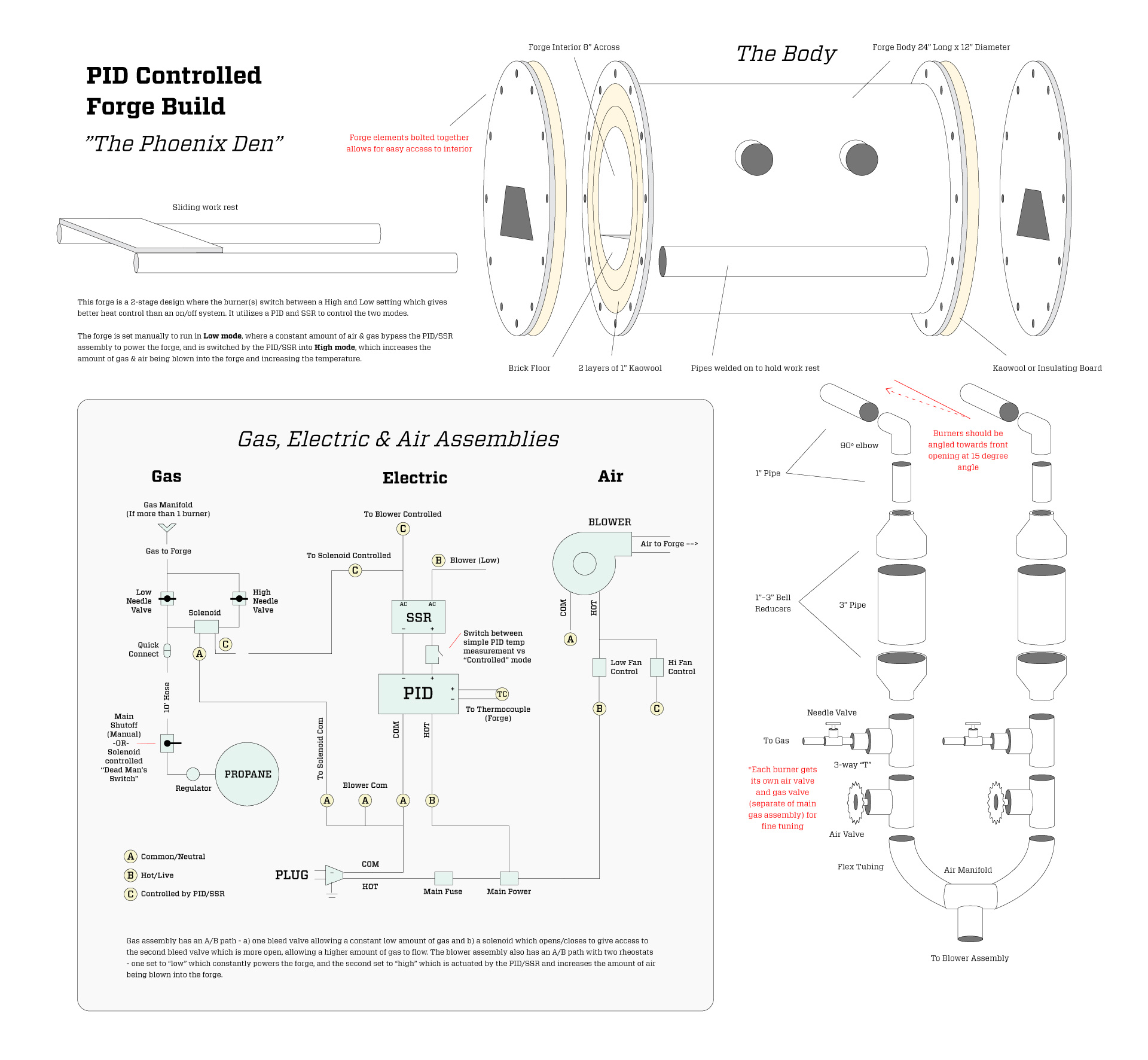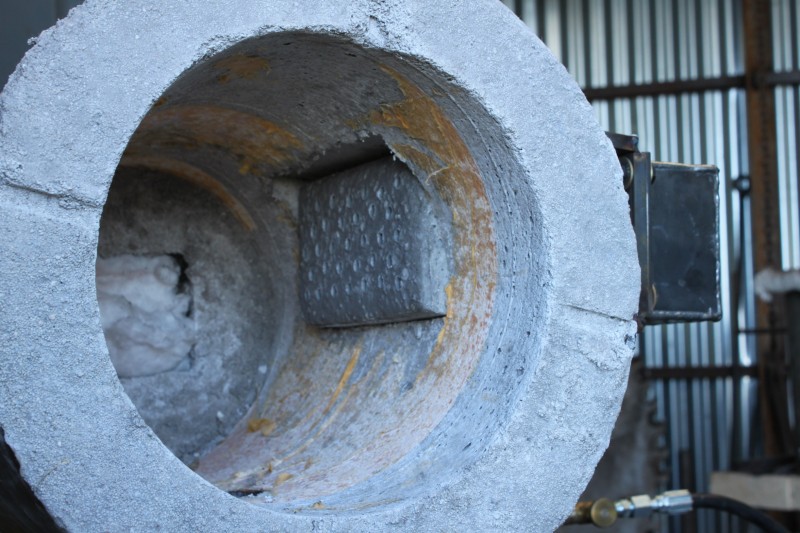- Joined
- Aug 5, 2014
- Messages
- 213
So after going through the stickys a couple weeks ago and finding all of the amazing plans for different PID controlled forges, tempering ovens, salt pot etc, I've switched gears fully to creating a really high-functioning PID controlled forge & heat treating oven.
First off, thanks to other members who shared all of their information on this, especially Stacy.
I won't be back home for another several weeks so at the moment I am in the planning & scheming phase, which has been a lot of fun. I won't rehash all of the information from other stickies but can provide links to other good threads and some condensed notes.
I'm interested in doing a 2-burner design. I mostly do knives, but would like for it to be large enough to do smaller swords as well, so what I'm thinking is a 12" by 24" body with either an 8" or 6" interior.
I designed out this "exploded view" of everything that needs to go into the forge. It's a work in progress in itself, as there are several areas that I'm still unsure about.

Here are some short bullets on the build/design:
PID Controlled to switch between High/Low flame settings for maintaining temperatures (as opposed to gas switching on/off)
I use mostly 220VAC so I will wire for that. Design can be adjusted easily for 110v
12 Diameter Tube 24 long
*Front and back will be cut on CNC plasma or Water Jet
2 x 1" layers of kao-wool or ins-wool. 1/4" to 3/8"coating of satanite with a thin coating of ITC-100 over that
Thermocouple - type K with 1/8" (8 gauge) lead size. Installed inside a ceramic TC sheath and the leads attached to a TC terminal block. Ceramic separators/insulators on the leads inside the sheath and the immediate area outside the forge.
Blower between 70 and 150 CFM controlled by 2 separate Rheostats for High/Low mode
Front opening of around 4" wide x 3" high and rear port approximately 3"x3"
Burners will enter the chamber from the side at a tangent near the top, angled about 15 degrees forward. Either horizontal, or even slightly uphill toward the forge
Here are links to the main electronics and functional components: (I'm not affiliated with any of these companies just fyi )
)
PID controller with Ramp/Soak
http://www.auberins.com/index.php?main_page=product_info&cPath=1&products_id=4
Thermocouple
http://www.auberins.com/index.php?main_page=product_info&cPath=20_3&products_id=39
Thermocouple sheath
http://www.auberins.com/index.php?main_page=product_info&cPath=20_3&products_id=40
Thermocouple Connector
http://www.auberins.com/index.php?main_page=index&cPath=7_43
K type thermocouple extension wire, multistranded
http://www.auberins.com/index.php?main_page=product_info&cPath=7_35&products_id=179
25Amp SSR
http://www.auberins.com/index.php?main_page=product_info&products_id=9
220VAC Solenoid (Most people will probably want 110v for this one, and seems like a lot of people have also used 12VDC Solenoids)
http://www.ebay.com/itm/AC-220V-Water-Air-Gas-Fuel-Electric-Solenoid-Valve-G1-4-N-C-/281397079685?hash=item418492ae85:g:iBEAAOSwLVZVkd5g
Again, there are some areas of this that I'm not entirely sure of. If the electronics seem to not match perfectly I can adjust the design and reupload for others who want to use this design as well.
Several main questions I have are:
1) What should the burner spacing be on the burners? Suggested by Fred.Rowe --> Burners should be 4" on center
2) What does "com" imply in wiring diagrams? grumpy_grinder "means common or neutral wire"
3) Is an 8" Forge interior overkill? I'm just trying to build with future projects in mind so a little more than 6" sounds good.
4) I'd like to make this modular so any tips on being able to keep it upgradable/changeable are great!
Thank you again everyone, I will modify and add to this as I go. Looking forward to it!
First off, thanks to other members who shared all of their information on this, especially Stacy.
I won't be back home for another several weeks so at the moment I am in the planning & scheming phase, which has been a lot of fun. I won't rehash all of the information from other stickies but can provide links to other good threads and some condensed notes.
I'm interested in doing a 2-burner design. I mostly do knives, but would like for it to be large enough to do smaller swords as well, so what I'm thinking is a 12" by 24" body with either an 8" or 6" interior.
I designed out this "exploded view" of everything that needs to go into the forge. It's a work in progress in itself, as there are several areas that I'm still unsure about.

Here are some short bullets on the build/design:
PID Controlled to switch between High/Low flame settings for maintaining temperatures (as opposed to gas switching on/off)
I use mostly 220VAC so I will wire for that. Design can be adjusted easily for 110v
12 Diameter Tube 24 long
*Front and back will be cut on CNC plasma or Water Jet
2 x 1" layers of kao-wool or ins-wool. 1/4" to 3/8"coating of satanite with a thin coating of ITC-100 over that
Thermocouple - type K with 1/8" (8 gauge) lead size. Installed inside a ceramic TC sheath and the leads attached to a TC terminal block. Ceramic separators/insulators on the leads inside the sheath and the immediate area outside the forge.
Blower between 70 and 150 CFM controlled by 2 separate Rheostats for High/Low mode
Front opening of around 4" wide x 3" high and rear port approximately 3"x3"
Burners will enter the chamber from the side at a tangent near the top, angled about 15 degrees forward. Either horizontal, or even slightly uphill toward the forge
Here are links to the main electronics and functional components: (I'm not affiliated with any of these companies just fyi
PID controller with Ramp/Soak
http://www.auberins.com/index.php?main_page=product_info&cPath=1&products_id=4
Thermocouple
http://www.auberins.com/index.php?main_page=product_info&cPath=20_3&products_id=39
Thermocouple sheath
http://www.auberins.com/index.php?main_page=product_info&cPath=20_3&products_id=40
Thermocouple Connector
http://www.auberins.com/index.php?main_page=index&cPath=7_43
K type thermocouple extension wire, multistranded
http://www.auberins.com/index.php?main_page=product_info&cPath=7_35&products_id=179
25Amp SSR
http://www.auberins.com/index.php?main_page=product_info&products_id=9
220VAC Solenoid (Most people will probably want 110v for this one, and seems like a lot of people have also used 12VDC Solenoids)
http://www.ebay.com/itm/AC-220V-Water-Air-Gas-Fuel-Electric-Solenoid-Valve-G1-4-N-C-/281397079685?hash=item418492ae85:g:iBEAAOSwLVZVkd5g
Again, there are some areas of this that I'm not entirely sure of. If the electronics seem to not match perfectly I can adjust the design and reupload for others who want to use this design as well.
Several main questions I have are:
1) What should the burner spacing be on the burners? Suggested by Fred.Rowe --> Burners should be 4" on center
2) What does "com" imply in wiring diagrams? grumpy_grinder "means common or neutral wire"
3) Is an 8" Forge interior overkill? I'm just trying to build with future projects in mind so a little more than 6" sounds good.
4) I'd like to make this modular so any tips on being able to keep it upgradable/changeable are great!
Thank you again everyone, I will modify and add to this as I go. Looking forward to it!
Last edited:






